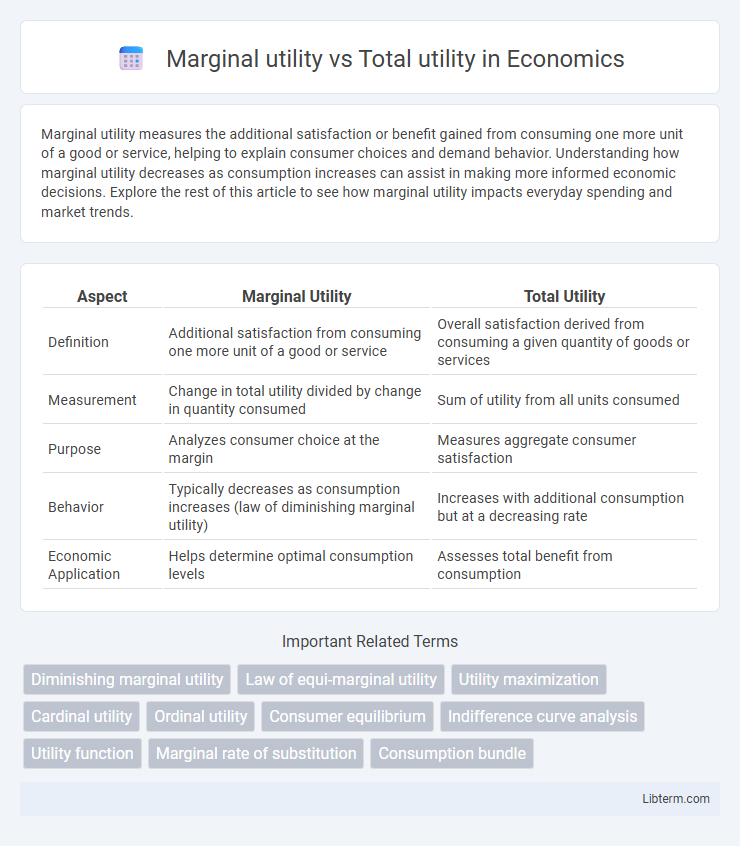Marginal utility measures the additional satisfaction or benefit gained from consuming one more unit of a good or service, helping to explain consumer choices and demand behavior. Understanding how marginal utility decreases as consumption increases can assist in making more informed economic decisions. Explore the rest of this article to see how marginal utility impacts everyday spending and market trends.
Table of Comparison
| Aspect | Marginal Utility | Total Utility |
|---|---|---|
| Definition | Additional satisfaction from consuming one more unit of a good or service | Overall satisfaction derived from consuming a given quantity of goods or services |
| Measurement | Change in total utility divided by change in quantity consumed | Sum of utility from all units consumed |
| Purpose | Analyzes consumer choice at the margin | Measures aggregate consumer satisfaction |
| Behavior | Typically decreases as consumption increases (law of diminishing marginal utility) | Increases with additional consumption but at a decreasing rate |
| Economic Application | Helps determine optimal consumption levels | Assesses total benefit from consumption |
Understanding Marginal Utility
Marginal utility measures the additional satisfaction gained from consuming one more unit of a good, highlighting how utility changes with incremental consumption. It is key for decision-making in economics, as consumers allocate resources to maximize total utility. Understanding marginal utility helps explain the law of diminishing returns, where each extra unit adds less satisfaction than the previous one.
Defining Total Utility
Total utility refers to the overall satisfaction or benefit a consumer derives from consuming a specific quantity of goods or services. It measures the cumulative happiness or fulfillment obtained as consumption increases. Understanding total utility is essential for analyzing consumer choice behavior and demand patterns in economics.
Key Differences Between Marginal and Total Utility
Marginal utility measures the change in total utility derived from consuming one additional unit of a good or service, while total utility represents the overall satisfaction obtained from all units consumed. Marginal utility typically decreases as consumption increases, reflecting the law of diminishing marginal utility, whereas total utility generally rises until it reaches a maximum point. Understanding the key difference helps businesses and economists optimize consumer satisfaction and resource allocation by analyzing incremental benefits versus aggregate satisfaction.
The Law of Diminishing Marginal Utility
Marginal utility measures the additional satisfaction gained from consuming one more unit of a good, while total utility represents the overall satisfaction from all units consumed. The Law of Diminishing Marginal Utility states that as consumption increases, the marginal utility of each additional unit decreases, leading to slower growth in total utility. This principle explains consumer behavior and demand curves by highlighting that the benefit of extra units declines over time.
Practical Examples of Marginal and Total Utility
Marginal utility measures the additional satisfaction obtained from consuming one more unit of a good, such as enjoying one more slice of pizza which might provide a high level of enjoyment initially but less with each subsequent slice. Total utility represents the overall satisfaction from all units consumed, like the cumulative happiness from eating multiple slices of pizza during a meal. Practical examples show that while total utility increases with consumption, marginal utility typically decreases, illustrating the law of diminishing marginal utility common in consumer behavior analysis.
Marginal Utility in Consumer Decision-Making
Marginal utility measures the additional satisfaction a consumer gains from consuming one more unit of a good or service, playing a crucial role in consumer decision-making by influencing choices at the margin. As marginal utility typically decreases with each additional unit, known as the law of diminishing marginal utility, consumers allocate their budget to maximize overall happiness. Understanding marginal utility enables firms and policymakers to predict consumer behavior, optimize product pricing, and improve market efficiency.
Graphical Representation: Marginal vs Total Utility
The graphical representation of marginal utility versus total utility shows total utility as a continuously increasing curve that eventually plateaus, reflecting saturation point where additional consumption adds no further satisfaction. Marginal utility is depicted as a downward-sloping curve, illustrating the law of diminishing marginal utility, where each additional unit consumed provides less extra satisfaction than the previous one. The intersection of marginal utility with the horizontal axis marks the peak of total utility, indicating no further net gain in overall satisfaction.
Importance of Marginal Utility in Economics
Marginal utility measures the additional satisfaction gained from consuming one more unit of a good, playing a crucial role in consumer decision-making and resource allocation. It guides businesses and economists in understanding demand curves, pricing strategies, and optimizing consumption patterns. The concept of diminishing marginal utility explains why consumers are willing to pay less for additional units, influencing market equilibrium and economic efficiency.
Limitations of Utility Measurement
Measuring marginal utility and total utility faces significant limitations due to the subjective nature of individual preferences and the difficulty in quantifying satisfaction. Utility is inherently qualitative, making it challenging to assign precise numerical values or compare utility across different consumers objectively. Moreover, changes in external factors, such as income and market conditions, further complicate the accurate measurement of utility over time.
Conclusion: Implications for Economic Analysis
The distinction between marginal utility and total utility is crucial for understanding consumer decision-making and resource allocation in economic analysis. Marginal utility, the additional satisfaction from consuming one more unit of a good, guides optimal consumption levels, while total utility measures overall satisfaction from all units consumed. Recognizing this relationship enables economists to predict demand patterns and design policies that enhance welfare by aligning consumption with utility maximization.
Marginal utility Infographic

 libterm.com
libterm.com